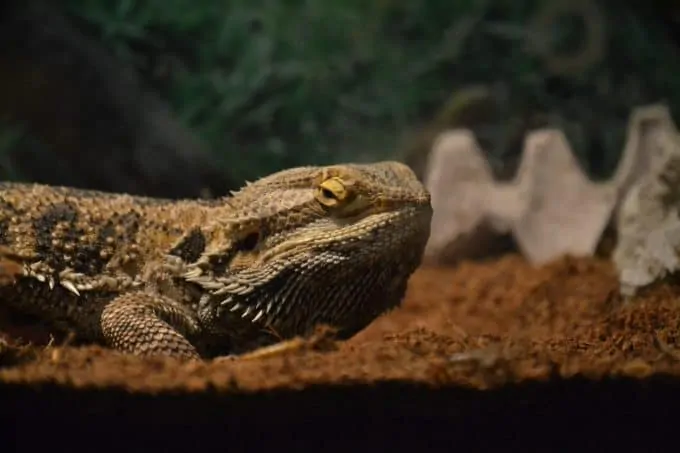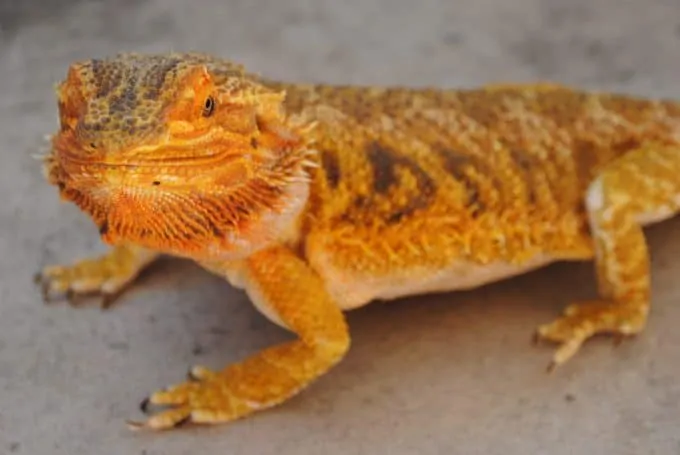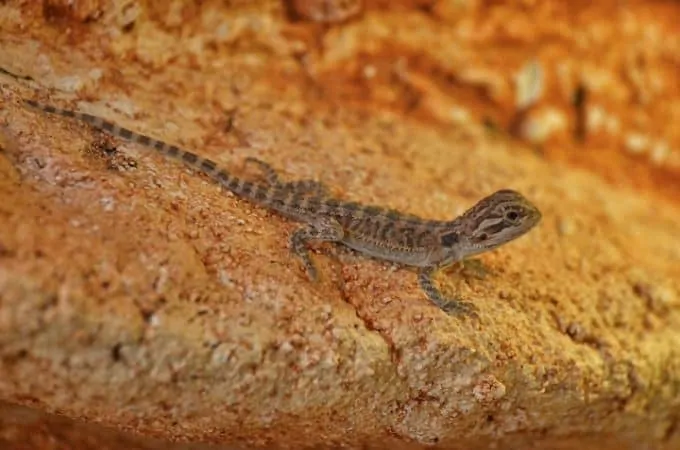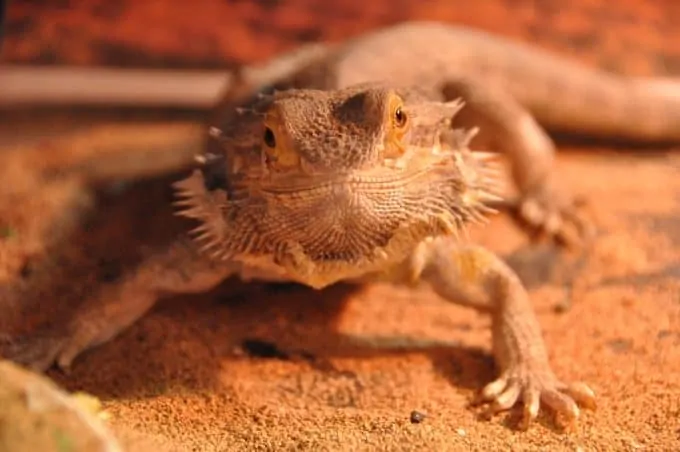April 23th, 2024: Article reviewed and updated by Dr. Mohsin Iqbal
Bearded dragons can stop eating or lose their appetite for a variety of reasons. We as first-time owners of these lizards may experience worry when they go off feed. Reptiles don’t need to eat every day, and sometimes a few days off is perfectly normal.
There are environmental factors that may also contribute to lack of appetite, such as temperature, humidity or even the time of year. To help ease your concerns, I have listed a few reasons your beardie might be uninterested in food and some possible solutions below.
Key Takeaways
- Bearded dragons can stop eating due to environmental factors (temperature, humidity), stress, illness, brumation, or natural aging.
- Look for signs of dehydration or illness when your bearded dragon is off its food.
- To stimulate appetite, offer soft, flavorful foods like pumpkin puree, baby food, or juicy insects like mealworms and Hornworms.
- If your bearded dragon continues to refuse food or shows signs of illness, consult a reptile veterinarian immediately.
Why Your Bearded Dragon Is Not Eating?
There are few reasons why your bearded dragon may lose his appetite or stop eating altogether.
Temperature & Humidity
The temperature and humidity within the enclosure might be too high or too low, and this can interfere with proper digestion of food. A reading of 30-40% is desirable. A basking spot of 100-110 degrees F works well for my own beardie. Accurate temperature and humidity gauges are a must in any beardie enclosure. Measure and adjust temps until they are within the best range for your lizard’s comfort.
Stress
Bearded dragons can be easily stressed by changes in the environment like loud noises, other pets, or excessive handling. Stress releases hormones that can reduce the appetite and lead to lethargy. Even a new decoration in their tank can cause short-term anxiety.
Parasites
Feeder insects can carry parasites like pinworms or coccidia that can make your beardie sick, and less inclined to eat their favorite foods like Dubia roaches. Other signs to watch out for are lethargy and diarrhea. You will need to take your beardie to a reptile vet to get a fecal exam to find out what type of parasite you are dealing with. Oral medication is generally given for a course of about a week or two.
Brumation
Some bearded dragons go into a form of semi-hibernation referred to as brumation. It is a natural state of reduced activity and metabolism that some adult bearded dragons may experience, typically during cooler months. It’s their wild ancestors’ way of coping with scarce resources during winter. They sleep most of the time but may wake to bask or occasionally take a small meal. Some dragons do not eat or poop during this period which may last for a few months. You will need to soak them at least twice a week to keep them hydrated during this time.
Age
As bearded dragons get older, their metabolism naturally slows down. They require smaller but more frequent meals and might be less enthusiastic about their food. While a lower appetite can be a normal part of aging, you should monitor your senior beardie closely for signs of illness.
Shedding
Bearded dragons shed their skin in patches throughout their lives. The shedding process can be itchy or uncomfortable, which makes them less interested in food temporarily. You might notice loose, flaky skin or a change in their usual vibrant colors as they prepare to shed.

Hunger Strike
For the first year of life, bearded dragons eat nothing but insects. Getting these lizards to accept greens and veggies can be challenging. They can straight up refuse to eat for weeks until supplied with their favorite bugs.
For older dragons who may favor certain fruits or veggies, you’ll have to get crafty to sneak in variety to their diet.
Impaction
Impaction occurs when a bearded dragon ingests something it can’t digest, such as loose substrate (like sand) or overly large prey items like mealworms. The material blocks their digestive tract, causing discomfort, bloating, and a refusal to eat. Impaction can be serious and requires prompt attention.
Injuries
Injuries, such as broken bones, burns, or infections, can cause pain and discomfort in bearded dragons. That leads to decreased appetite. If your beardie seems reluctant to eat and you notice any visible injuries or unusual behavior, go for a reptile vet immediately.
Other Illnesses
Conditions like respiratory infections, mouth rot, metabolic bone disease, and other health issues can all lead to a loss of appetite in bearded dragons. If your beardie shows additional symptoms like lethargy, abnormal discharge, labored breathing, or difficulty moving then your beardie needs to be checked out by a good reptile vet. There could be an underlying illness causing these symptoms, and if it is serious, you’ll want to catch it early.
How Long Can A Bearded Dragon Go Without Food?
As desert dwelling reptiles, bearded dragons can go weeks without food, sometimes a few months. Young bearded dragons should not go more than a few days without food because they have limited fat reserves and require regular, protein-rich meals for proper growth. On the other hand, healthy adults with extra body fat can technically survive longer without food, sometimes weeks or even up to two months in exceptional circumstances (such as during brumation). This allows them to survive in their native habitat when food sources are scarce. In captivity, this usually occurs during brumation. There are a few things you can keep an eye on to make sure your beardie stays healthy if he goes off food for a while.
- Weekly Weigh-Ins – I weighed my beardie often in the first year I had him and recorded the weights and dates in a notebook. This helped me to keep track of his growth, and changes in weight. This was very useful during his brumation.
- The weight range for adult bearded dragons can be anywhere from 350 – over 600 grams. Their weight readings will fluctuate after taking a meal, getting soaked, and pooping. My beardie lost at least 10 grams after a bowel movement. Be sure to mark down any changes, especially if they ate, pooped, or soaked before recording weights.

Signs of Eating and Drinking
- Full-Fat Pads on Head – The top of your dragon’s head should have two little fat humps. They should NOT be sunken in, or show visible bones.
- The base of Tail is Thick, No Hip Bones Visible – The base of the tail should be well rounded with no visible hip bones under the skin.
- Ribs Not Visible Under Skin – Ribs should be just barely visible under the skin of the back.
- Pinched Skin Snaps Back In Place – To test for possible dehydration, pinch the skin of your beardie’s back. If it snaps back in place quickly, all is good. If it’s slow to return in place, then you need to hydrate by soaking for around 15-20 minutes.
A Note On Soaking & Drinking – I try to soak my bearded dragon 10-15 minutes once a week during the spring and summer when he is eating regularly, and twice a week during winter when his appetite dwindles.
While beardies do absorb some water through soaking, it’s also good to try to get them to drink if you can. Most of the time, these lizards won’t actively drink from a dish, but you can try the ‘drip method’.
This involves using a syringe to drip water on the tip of their mouth until they start licking. This has worked for me more than once. Don’t worry if your beardie doesn’t do this right away, since it may take a few tries for them to get the idea.
Why Your Baby Bearded Dragon Won’t Eat
- Failure to Thrive – If a baby beardie refuses to eat on their own and continues to gain no weight, it could be due to factors such as weak genetics, poor husbandry of hatchlings, or other unseen causes. A reptile vet is needed to assess the best course of action for the baby beardie, and it may mean humanely euthanizing if they can’t recover.
- Environment – Issues with temperature could be just as much a problem for babies as it is for adults. The ambient temperature inside the enclosure should be 80-85 degrees F. The basking area should range 95-110 degrees F.
- Competition with Cagemates – Housing babies together can lead to nipped tails and toes, and not enough food to go around. Housing babies individually will allow them to eat enough food and to feel safe.
- Enclosure too big/ Doesn’t feel safe – Starting a baby beardie off in a smaller enclosure may help him feel more secure. Smaller spaces make them feel less vulnerable to attack by predators. Multiple hiding spots will help reduce stress since they can scramble for cover if they ever feel scared. As they grow, your bearded dragon’s fear will subside and he will sit out in the open proudly.

How To Get Your Beardie To Eat
Foods to Stimulate Appetite
Whenever I’ve had trouble getting my beardie to eat on his own, I have had great luck using canned pumpkin. I usually mix in chopped greens or vitamin supplements.
Some dragons may eat it straight from their usual food dish, or you can try spoon-feeding them. Along with canned pumpkin, vegetable-based baby foods like squash, green beans, or sweet potato puree, can also be a good option. Just make sure they have no added sugar or spices! Their soft texture and gentle smell can sometimes tempt even the pickiest eaters.
Other options for tempting a picky eater include juicy silkworm larvae or hornworms (occasionally due to high fat). Their soft bodies and high moisture content make them easy on the tummy and often irresistible to a reluctant beardie.
Fruit shouldn’t be a staple due to sugar content but small amounts of berries, mango, or melon can provide a sweet and enticing treat on occasion for beardies.
Food Colors
Beardies seem to be attracted to certain colors more than others, such as red, green, or yellow. Many of their favorite foods possess these colors, and they’re naturally drawn to them.
Pumpkin, butternut squash, yellow squash, red peppers, strawberries, raspberries, etc. are all things that will catch the eye of your dragons.
Dish Colors
Food dish colors may also place a part in influencing appetite in the same way as food. I have used both blue and red dishes, and I have to say that the reddish seems to get more of a response. Warm colors such as red, orange, or yellow may be something to give a try.
Bugs/Bait & Switch
Here’s another method to try if your beardie is off feed, but still eating bugs. Use your dragon’s favorite bugs and give them to him one at a time. While he is chewing, stick greens or veggies in his mouth.
They may manage to spit some of the food out, but you might have some success. This method can be hit or miss because some beardies (like mine) will get wise to what you’re doing, and decide to keep their mouth closed tight.
Force Feeding
Force-feeding with a syringe should only be done under the direction of a qualified reptile vet. It can be very stressful, but there are some occasions which may be necessary. Depending on what is going on with your bearded dragon, your vet will recommend a type of solution to feed, like Oxbow’s Critical Care.
I strongly suggest seeing a reptile vet before deciding to force-feed your pet, and especially if you’ve never done so before. Your vet can show you how to safely do it at home under the right direction.
Take Care!
Did you enjoy these helpful tips provided in the article? I can’t tell you how many articles I read through as a first-time owner of a bearded dragon.
It meant a great deal to me to learn what was going on with my beardie and how to address any issues he might have. Your beardie’s health and well-being are just as important to you, and I thank you for learning from my experience.
If you liked my article, please share it! Let me hear your thoughts in the comments below, as I’d love to hear from you.



11 Comments
My beardie is going to be 16 years old this March and seems way too thin and frail. In the past year he has certainly lost his appetite exponentially and I am very worried. I live in a very remote area now and there are no exotic pet vets. He still loves greens but will not eat any protein. Sometimes I wrap a superwork in a small piece of lettuce like a taco and he will eat it but then he is upset and will not eat for 2 to 3 days afterwards. I sometimes trick him into eating when he is expelling heat and has his mouth open. It’s exhausting and I am not sure what to do. Any suggestions?
Hey Jenni,
First off, it’s amazing that your beardie has reached 16 years old – that’s quite an achievement! However, it’s concerning that he’s losing his appetite and weight. In older beardies, this can be pretty common, but it’s still something to address.
You’re doing a great job trying to keep him fed. But if he’s refusing protein and getting upset, it might be more stressful than beneficial for him.
Since vet access is a challenge for you, let’s try some gentle methods. Continue offering greens since he loves them. For protein, you could try softer options like silkworms or small amounts of well-cooked chicken or fish. These might be easier for him to eat and digest.
Also, ensure his habitat is warm enough and he’s getting enough UVB light, as these can impact his appetite.
Take care, and best of luck with your beardie! 🦎✨
I have had my little bearded dragon is around 10 years old.
He has always been a picky eater but in the last few weeks I have noticed he don’t eat like he has had in the past. He don’t eat the crickets he allows them walk all over him.
He likes romaine lettuce but he lets the crickets eat it.
Is this a vet appointment?
Hi Shelby,
Decreased appetite in a bearded dragon can have several causes. Given your dragon’s age, it’s possible that he’s slowing down a bit. However, a significant change in eating habits could also suggest a health issue.
If your bearded dragon is also displaying other signs of illness, such as lethargy, weight loss, or changes in bowel movements, a vet visit would be a good idea.
Additionally, keep in mind that bearded dragons require a varied diet, including a mix of greens (kale, collards, mustard greens – romaine lettuce is not very nutritious), vegetables, and insects. Make sure the temperatures in the enclosure are appropriate as well, as this can impact appetite.
You’re on the right track in being observant about your bearded dragon’s behavior and eating habits. It’s always better to be safe and consult a vet if you’re unsure. Meanwhile, continue to research about senior bearded dragon care for more information.
Can I empty out my bearded dragons enclosure during feeding? Or should I get a separate enclosure?
Hi Anthony,
It’s not necessary to empty out your bearded dragon’s enclosure during feeding, as long as you’re feeding them in a designated area within the enclosure. However, if you’re concerned about the possibility of substrate or food particles getting stuck in the enclosure, you could consider feeding your bearded dragon in a separate enclosure specifically designated for feeding time.
This can make cleaning up after feeding easier and help prevent any potential health issues from ingesting substrate or other foreign objects. Ultimately, the choice is up to you and what you feel is best for your bearded dragon’s health and well-being.
I took on a Bearded Dragon 3 weeks ago. I already have 7 Leopard Geckos, 3 Corn Snakes and a Mexican Black King Snake, so not ignorent about reptiles! He (Steve) arrived in a 4x2x2 vivarium, with UV and basking light. However the rest of the set was completely wrong, sand as substrate, no salad bowl….Steve is 20 months old, 17″ long and the tip of his tail is dead (about 1″) and was fed salad just twice a week, as for bugs he was mostly fed locusts and the occasional cricket! Steve did have a water bowl but this was full of sand!
The UV was not covered or properly secured and Steve pulled the bulb down on a daily basis, finding him sitting on it regularly, the basking bulb was also uncovered and 7″ from the basking rock!
With all this now said, I have rectified all the problems, but my major problem is Steve WILL NOT EAT SALAD, I hoped he would once his set was correct but this is not the case. I have spent a little fortune on a whole range of fruits and vegetables and they remain untouched, I have put worms in his bowl in the hope that movement would interest him, i have tried hand feeding him, my last option is to NOT FEED anything for a couple of days and then just offer salad, do you think this is a wise course of action as he is now an adult and he needs his veggies. Any advice and guidance much appreciated
Hi Sam,
It sounds like you’ve done a great job improving Steve’s living conditions and providing him with a healthy environment.
One approach you can try is to offer a variety of vegetables and fruits to see if there are any that Steve particularly likes. You can also try chopping or shredding the vegetables into small pieces and mixing them with live insects or worms to make them more appealing.
Withholding food for a couple of days and then offering only salad is another approach that some bearded dragon owners have found successful. However, it’s important to monitor Steve’s health and behavior closely if you decide to try this approach.
Keep up the good work, and continue to offer Steve a healthy and varied diet. With time and patience, he may start to develop a taste for his greens.
You forgot uvb- they are extremely important for not eating – a dragon cannot absorb or synthesize his calcium w/ out correct uvb – that means NO coils – a long tube fixture– the basking temps taken w/ a digital probe thermometer- and uvb are the lifelines to the dragon
Hi Karrie,
That is correct, thank you for pointing this out. I will make sure we add in a section about UV lighting.
Your article was a great help! Full of information but to the point. Thank you so much!!!